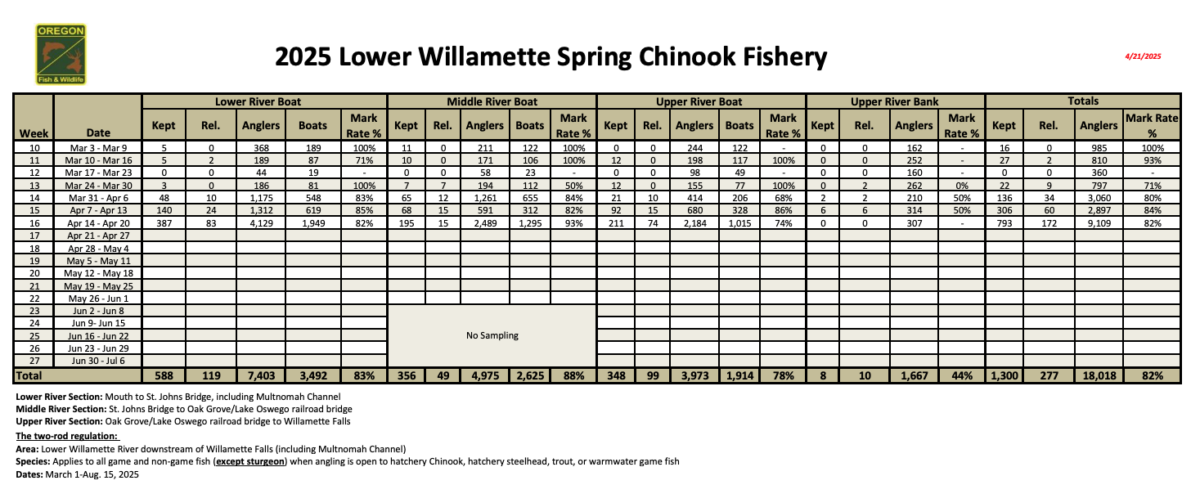
Fishing For Willamette Springers With Guide David Johnson
Wednesday was a great day to go out for spring Chinook with a guy who grew up fishing the Willamette and nearby Clackamas Rivers.
David Johnson and his eggs and sandshrimp concoctions were on point as we went four for four, with two keepers and two wild fish released in the Oregon City area under sunny late April skies.
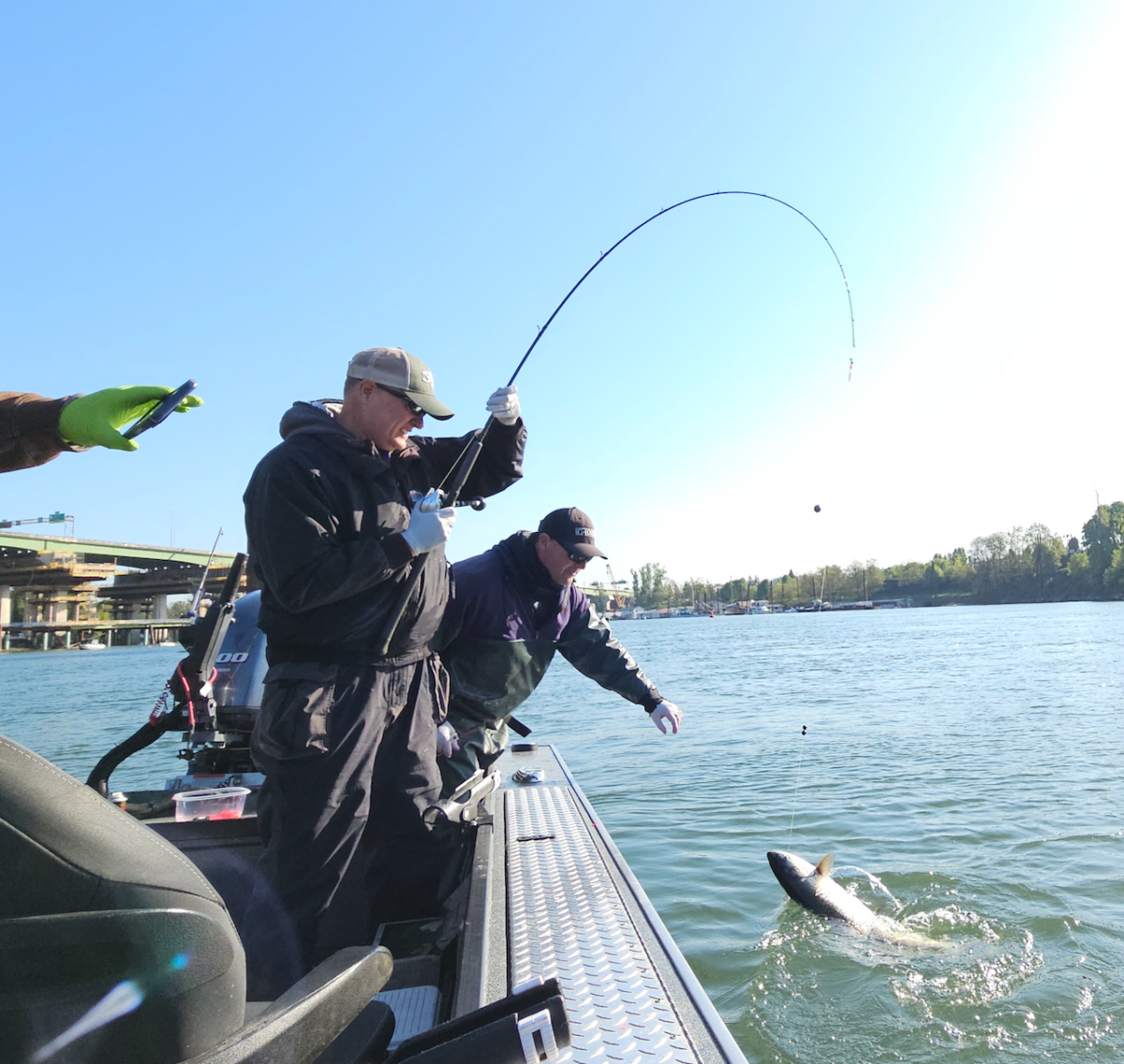
Our boat and many others in the fleet were mostly back-trolling on the inside corner below I-205 and along Goat Island, but the day’s first Chinook came while back-bouncing above the interstate bridge.
“The bite wasn’t hot, but by moving around as well as trying multiple scents we found what they wanted (and it) worked out,” summarized Johnson, operator of David Johnson’s Guide Service (503-201-4292).
The Willamette has been dropping for about two weeks and yesterday was running around 54 degrees with a turbidity reading below 3.5 FNU at the Morrison Bridge gauge downstream in Portland, fishy conditions.

This year’s count at the falls fish ladder is also nearly twice as high as last year’s low return at the same point and just below the 10-year average. While during an Outdoor GPS appearance last Saturday morning Johnson suggested lower passage numbers might be preferable because it would mean fish were kegging up instead of jetting upstream, what we did yesterday should be a viable way to catch springers until the river warms up and anglers look to pull out their 360s and 3.5s to troll for the tasty salmon.
“Hot weather will hurt. It should last until water temperature rises to 60,” says Johnson. “Two thousand fish have already crossed the falls. If water temperature goes below 60 because of rain and runoff, it will pick back up.”
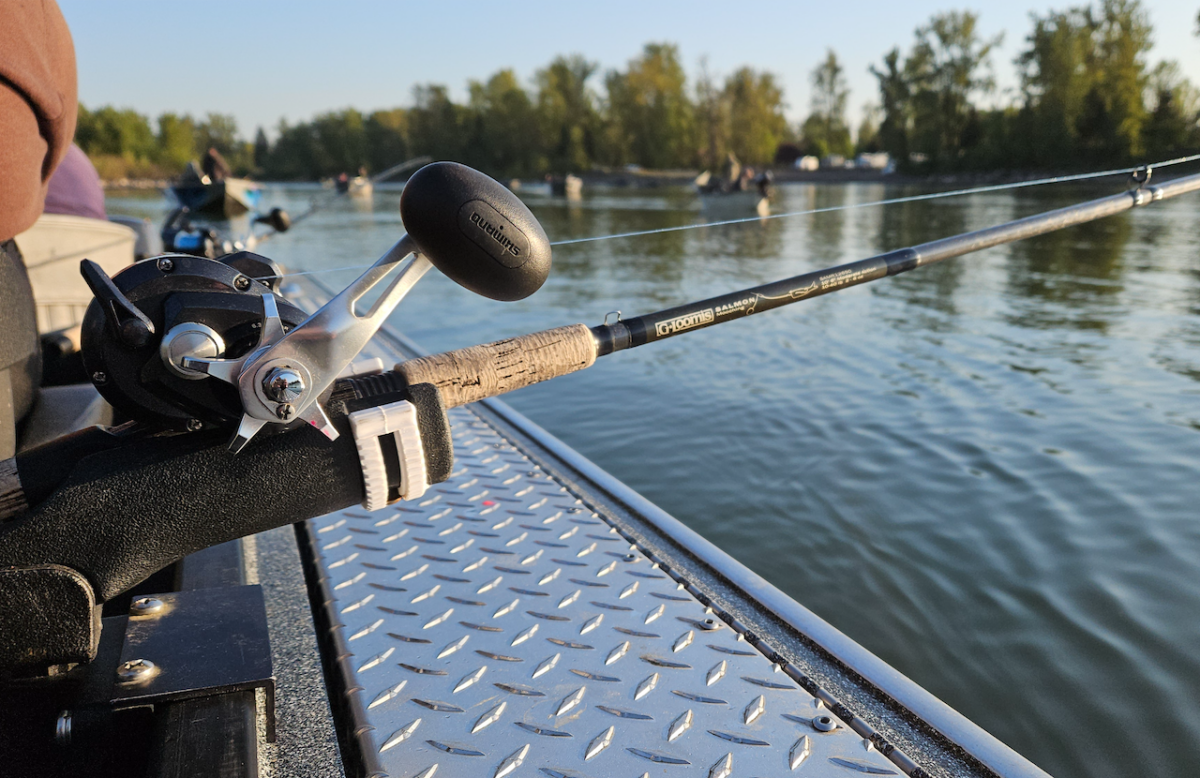
JUST A BIT AFTER 6 A.M., we pushed off from the long dock at Oregon City’s Jon Storm Park – part of the very sportfishing- and water-access-friendly infrastructure on the Willamette below the falls – and motored a couple hundred yards over to the West Linn side of the river. There, we ran our divers and baits out in about 16 feet of water or so.
As I was sitting closer to the front of the boat, Johnson had me and the gent to my left run our lines out 80 feet on the linecounter reels, while the two guys in front of us sent their setups out 85 feet. We then slowly backed our way downstream at a pace that would make plugging for winter-runs feel like a 100-yard dash.
As we made that first pass, a Chinook bit for the boat just below us and then on our second pass, as we ran our gear out in slightly deeper water, a rod went off on a sled next to us. By 8 a.m. I’d counted five fish, and soon a sixth as a sea lion came down for breakfast.
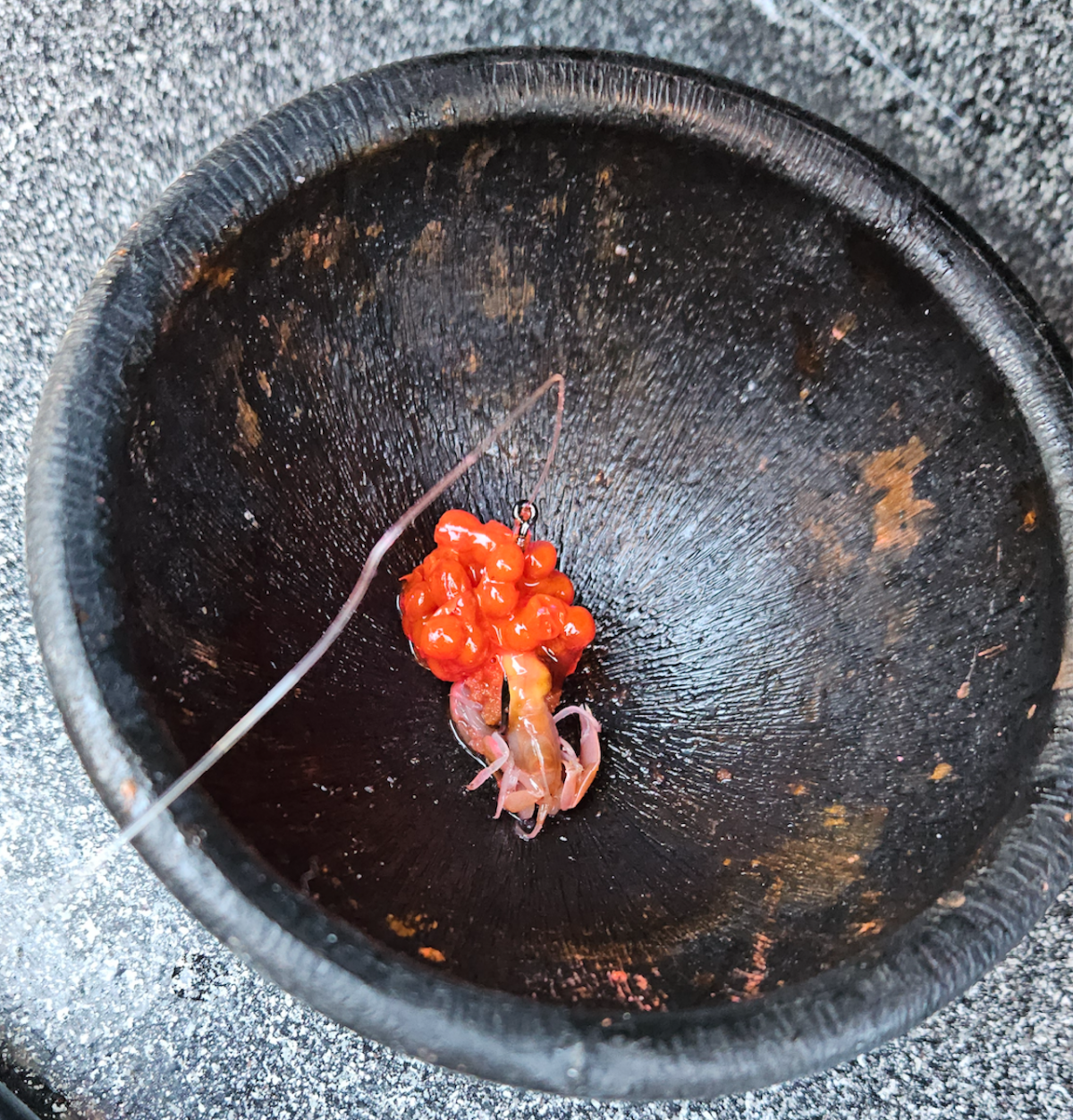
With no takers of our own, we ran upstream to between historic Arch Bridge and the barges supporting the earthquake-retrofitting of the George Abernethy Bridge. There, a couple boats were trolling, another three were jigging, and five were set up in the hogline known as Lake Line, where a certain source of mine and their partner put a couple in the bleed bucket last weekend.
Johnson rebaited us while an experienced member of the day’s crew rigged up for back-bouncing. Just then one of the hogliners hooked a king that zipped around on the surface until it came off.
As the jigging boat traffic sorted out, we slotted into a gap in the hogline and ran our stuff out. In this deeper water, Johnson instructed me to spool out 85 feet on the linecounter.

It wasn’t long before our back-bouncer felt a bite and provided a clinic on how to patiently, patiently, patiently wait to set the hook instead of immediately reefing back (like I would have done and pulled the bait out of the fish’s mouth). Unfortunately, that fish turned out to be wild, but fortunately for it, Johnson was the skipper. Leaving his nets in the bow, he grabbed the leader when the fish tired and with a quick scissor snip, it was on its way.
Others might have netted and pulled that Chinook into the boat for a picture, but at least with the Willamette’s wild springers, that’s not something Johnson does. When I fished with him in May 2023, I hooked a pretty nice one and was actually quite pleased when, as the fish came to the side of the boat, he slashed my line.
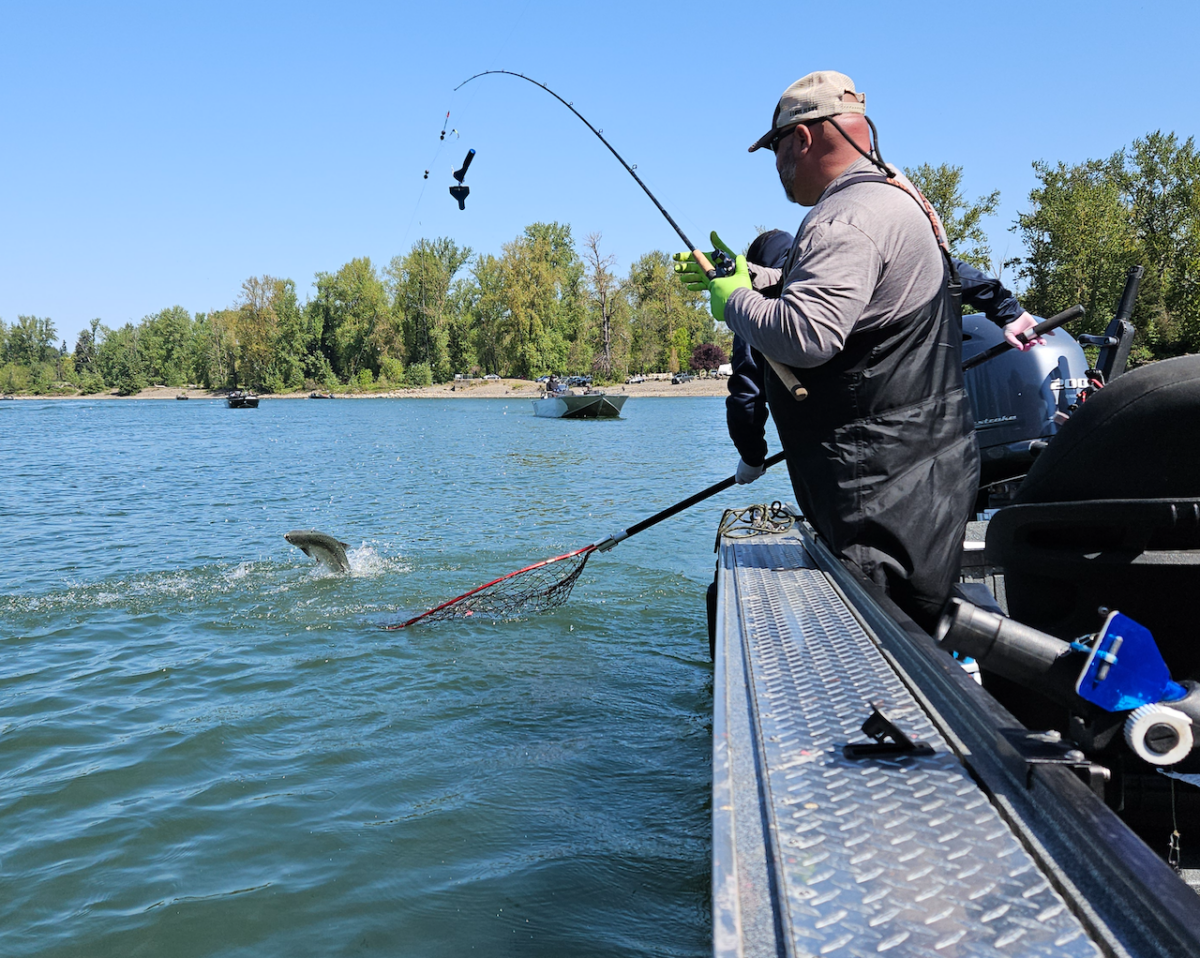
Earlier that day two years ago, he’d talked to us about how a hatchery worker told him of wild winter broodstock steelhead developing fungal infections in the shape of handprints and pointed out how long the Willamette’s wild Chinook would be in the river before spawning on the other side of summer’s stressful high heat (he posted about it and release methods here). It gelled with how I try to fish around native salmonids, going so far as to debarb my trebles and Big Rivers even when not called for in the regs so that I can more easily release any that have to go back.
BACK ON WEDNESDAY MORNING, we made a second pass through the gap in Lake Line, but without another go, Johnson headed back below I-205 and we ran our divers and bait out again along the West Linn side. A boat above us hooked up during our first pass, and on our second, in came our first hatchery fish of the day. As I beamed over it, Johnson had me hold it just so so that the purple-backed hen gleamed beautifully in the sun.
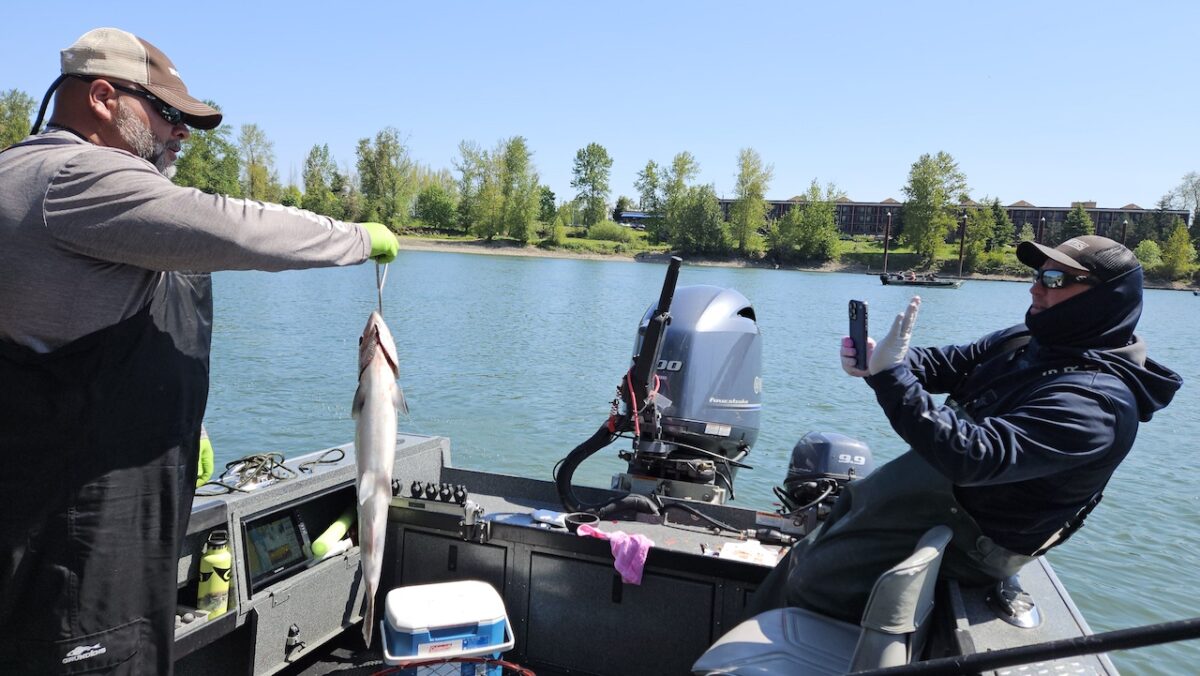
That’s another thing that I appreciate about Johnson, his meticulousness. Where in my own fishing I can descend almost into a state of panic trying to get my kayak rigged up and in the water as fast as possible (“Why are you yelling at me?!?” Amy asked last week over the phone as she caught me breathlessly rushing to put in at Sellwood before work one morning) or when I’m trying to get my gear back down as soon as possible after a bite or switching up after seeing a fish landed nearby, Johnson is the picture of calm.
After most passes Johnson would pull the boat to the side of the river and freshen up all of our baits with new eggs and sandshrimp from the multiple bait coolers and glass jars in the back of the boat. Each leader would get a quick line wipe-down just above the presentation to remove any extra egg goo, and then the juicy offering would get a little extra mojo. Before deployment the baits go into salsa cups beside each angler, keeping the various special sauces off the diamond plate and sides of the boat, which also makes for easier cleanup at the end of the day.

It all spoke to long practice – indeed, Johnson’s been fishing since childhood and guiding Northwest Oregon waters since the 1990s – and as if to show that that first keeper and his methodology were no fluke, the next pass soon produced a nice clipped buck for the angler in front of me. That fish was a bit of a rodeo because during the fight it picked up another one of our diver setups, forcing Johnson to clip that line and the Chinook to be fought with the extra gear dangling down, complicating the netting.
Speaking of setups, Johnson’s back-trolling rig consists of a slider on the mono mainline with about a footlong dropper to a diver, followed by two large red beads and a beadchain swivel. Below that is another 2-foot-or-so leader to two large black Lil’ Corkies for lift and a barrel swivel, then a roughly 4-foot leader to a 2/0 octopus hook, around which he folds a sandshrimp and a small gob of eggs via the egg loop. It ends up being a pretty tidy bait, and the fish absolutely love it. When he gutted my fish, the hook was pretty deep; it was almost tempting to check if stomach acids had begun to dissolve it.
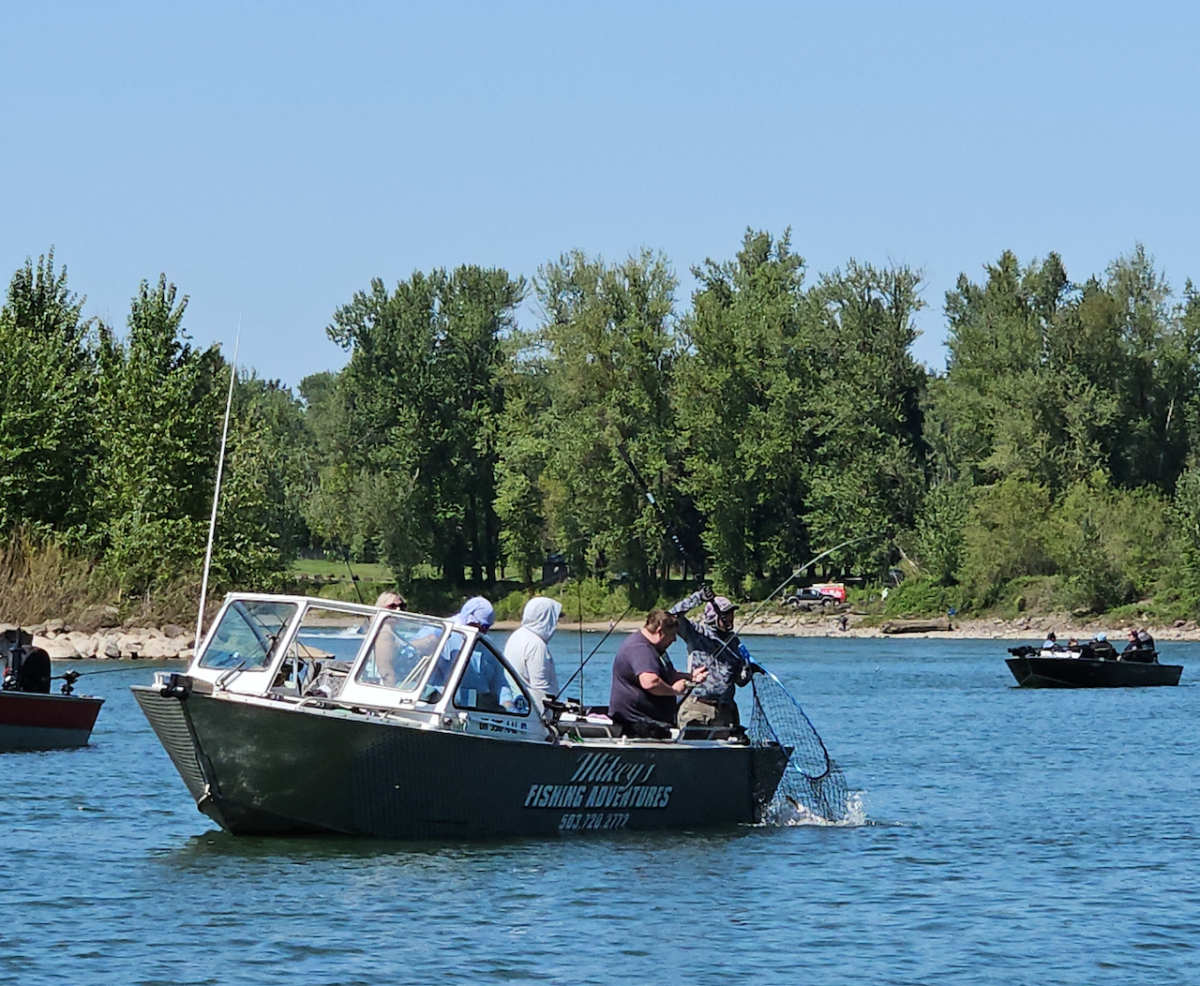
I WOULDN’T SAY WEDNESDAY was red hot, but there were more than enough bites to keep us on our toes, and when the fourth grabbed the bait on my line, I alerted the guy beside me and quickly moved out of the way so he had a chance to touch one too. Unfortunately for him, it turned out to be wild, and with another snip of Johnson’s scissors, that fish was also quickly back on its way after a spirited fight.
Again, it wasn’t just us finding fish yesterday. Springers were biting for Johnson’s fellow guides, including Mike Fisenko, and other anglers on the water were also hooking some. If I recall correctly, there were only two sea lion sightings. A bald eagle plucked either a sculpin or smolt off the surface just behind us as well.

But all in all, it was a very educational day about how to fish for Willamette spring Chinook, adding to a growing library that includes a trip with former guide Trey Carskadon at the mouth of the river a few Julys ago. It also showed fish could be caught throughout the day and with the last of the tide running out and starting to build again (there was flow throughout the day).
While I’m not sure I can apply yesterday’s specific techniques to my kayak fishing for springers, it was still good to observe Johnson at work and be able to pass along some of what I did experience, and I can try to incorporate other facets of his program into my own. (Serenity now, Walgamott.) It was time well spent in good company with a guide who knows his stuff, and I appreciated the opportunity.
Springer, it’s what for dinner this and the next couple nights – and hopefully it will soon be for you too.
